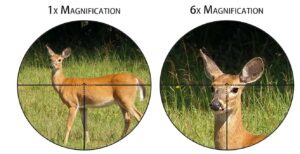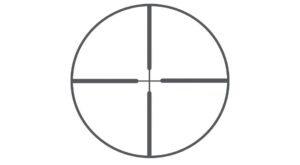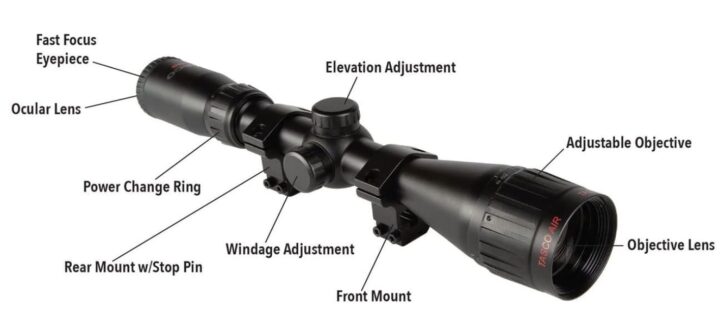Rifle scope optics explained
The world of rifle scope optics can be overwhelming, with a multitude of options and technical jargon. This is, however, fairly simple to understand when properly explained, as this article will do. From the lens, magnification level, and reticle kinds, we’ll cover all of the crucial aspects that will help you unleash the full potential of your rifle scope.
Understanding the Terminology of Rifle Scope Optics
Let’s start by breaking down some of the key terms you’ll encounter when exploring rifle scope optics.
Objective lens
The objective lens is positioned at the end of the rifle scope’s optics, on the side that faces the target. The primary purpose of the objective lens is to gather light and direct it inside the scope as well as to capture the initial image of the target. It is worth noting that the original image captured through the lens is inverted
The size of the objective lens determines how much light enters the rifle scope optics. A larger size allows for a greater amount of light and is best suited for use in low-light conditions since it maximizes the limited light that can be captured.
A larger objective lens on the other hand results in a bigger overall size of the rifle scope because it increases the overall diameter of the tube. Most shooters seek a compromise between the size of the objective lens and the overall dimensions and size of the rifle scope.
Magnification

This is the extent to which the size of the image has been enlarged over the original object or the target. A rifle scope’s optic comes with magnification because of a few reasons. One of the reasons is for the shooter to identify the target at greater distances, the other is to allow the placing of shots more accurately without moving any closer to the target.
While we’re at it, let’s take a look at the various magnifications offered;
Fixed magnification– this type of magnification gives the shooter only one preset magnification size such as 4x, or 8x. The Trijicon 4×32 ACOG Rifle is one example of a popular rifle scope with a fixed magnification
Variable Magnification– it gives the shooter the ability to choose different magnifications over a specified range such as 3-9x or 4-18x. It allows the shooter to select different magnifications from a predefined range, such as 3-9x or 4-18x. These scopes are more adaptable and provide the greatest results when aiming at targets at varying distances.
Ocular lens
This is also known as the eyepiece and it’s on the opposite side of the objective lens, the side that faces the eye. The ocular lens presents an upright, and magnified image of the target to the shooter. The ocular lens can be adjusted to vary the sharpness of the image and give the shooter a better view of the target
Reticle

The reticle is probably the single most vital component inside a rifle scope’s optics. The reticles are the markings that the shooter uses to align the rifle scope thus firearm with the target. They come in different designs depending on the manufacturer.
We have simplified reticles such as the Duplex Reticle which consists of thick outer lines that narrow down towards the center. This design allows for quick target acquisition and is versatile for various shooting applications.
There exist more complex ones like the BDC (bullet drop compensator) reticle which incorporate a series of markings that can be used to compensate for elevation and windage in place of adjusting the turret.
The choice of reticle depends on the shooter’s preference. While some shooters appreciate reticles with intricate markings that allow them to modify the aim with merely the reticle, others prefer simpler reticles that cover less of the target.
At the right budget there also exists rifle scopes with an illuminated reticle. An illuminated reticle is more visible both in bright light and low light conditions. You might also come across a glass-etched reticle going through your rifle scope options, and this means that the reticle is engraved directly, mostly inside the ocular lens. Glass-etched reticles are more robust and accurate because do not misalign over time.
Turret

The turret carries dials or knobs that are used to adjust the internal mechanisms in a riflescope’s optics. The location of the knobs isn’t predetermined; instead, it depends on the manufacturer. The adjustments on the turret are made to move the reticle and do so to alter the point of impact, to compensate for either the wind drift or the elevation of the target relative to the location of the shooter.
The adjustments on the turret are either vertical or horizontal for elevation and windage respectively. Compensating for these factors improves the accuracy as long as the shooter can do it right.
The turret sometimes includes parallax adjustments. parallax is the apparent shift in the position of the target when viewed from various angles via the scope’s optics. This occurs when the reticle and target are located on different planes. However, most rifle scopes are factory-calibrated for parallax, but only up to a certain distance.
Eye Relief
This is the maximum distance from the ocular lens/eyepiece to the eye of the shooter where the shooter can view a full image of the target. Simply explained, a scope with a longer eye relief allows the shooter to position their eye further. Long eye relief is good with calibers of heavy recoil because it allows the shooter to position their eye at a comfortable and safe distance from the eyepiece when aiming at a target
Adjusting and Zeroing Your Rifle Scope Optics
Once you’ve selected the perfect optics, it’s essential to adjust and zero it properly to ensure accuracy. These are the most common steps followed when adjusting the scope;
- Start by securely mounting the scope to your rifle using the appropriate mounting rings. Ensure it is properly aligned with the barrel to maintain accuracy.
- Use a bore sighting tool or align the reticle with the rifle’s barrel and a fixed object at a known distance.
- Head to the range and start with a close target. Fire a few shots, making adjustments to the windage and elevation knobs based on where the bullets hit. Follow the manufacturer’s instructions for precise adjustments.
- To fine-tune, move on to a more distant target and continue adjusting the windage and elevation knobs until the bullets consistently hit the center. Take your time and make small adjustments to avoid overcompensating.
Remember, zeroing your rifle scope may require multiple trips to the range. Patience and attention to detail are key to achieving optimal accuracy.
Tips For Maintaining Rifle Scope Optics
By incorporating these maintenance practices into your routine, you can ensure that your rifle scope optics remain in optimal condition, providing you with clear and precise optics for years to come.
- When not in use, keep your rifle scope protected with lens covers. These covers shield the lenses from dust, debris, and potential scratches.
- Use a soft, lint-free cloth to gently remove any dirt or smudges from the lenses. Avoid using abrasive materials or excessive force, as this can damage the lens coatings.
- Keep your rifle scope away from excessive moisture. If it gets wet, dry it thoroughly before storing it to prevent mold or fogging.
- Periodically inspect your rifle scope for any signs of damage or wear. Check the mounting screws, the adjustment knobs, and the overall condition of the scope. If you notice any issues, consult a professional for repairs or replacements.
Common Misconceptions About Rifle Scope Optics
There are several misconceptions surrounding rifle scope optics that can lead to confusion. Let’s debunk some of these myths and set the record straight:
Higher Magnification is Always Better
While high magnification can be beneficial for long-range shooting, it is not always necessary. Excessive magnification can make it more challenging to acquire targets quickly at close distances because a higher magnification results in a greater proportion of change with a small adjustment
Larger Objective Lens Equals Better Performance
While a larger objective lens allows more light to enter the scope, it doesn’t necessarily guarantee better performance. Other factors, such as lens quality and coatings, play a significant role in determining optical clarity and brightness.
Reticles Are Universal
Reticles can vary significantly across different scopes and manufacturers. It’s essential to understand the specific reticle type and its features before making a purchase.
Expensive Scopes are Always Superior
While high-end scopes often offer advanced features and superior build quality, there are budget-friendly options that deliver excellent performance. Consider your shooting needs and budget when selecting a scope.
By dispelling these misconceptions, you can make informed decisions when it comes to purchasing and using rifle scope optics.
Best practices for using rifle scope optics in the field
Now that you have a solid understanding of rifle scope optics, let’s explore some best practices for using them effectively in the field:
Proper Eye Relief-Maintain the proper eye relief distance, which is the distance between your eye and the eyepiece of the scope. This ensures a full field of view and prevents discomfort or injury from recoil.
Steady Shooting Positions-Practice shooting from different positions to find what works best for you. Whether it’s prone, kneeling, or standing, maintaining a steady shooting position is crucial for accuracy.
Understand Holdovers– If your reticle has bullet drop compensation marks, practice using them to compensate for bullet drops at different distances. This skill will come in handy when shooting at varying ranges.
Practice Range Estimation-Developing the ability to estimate range accurately is essential for long-range shooting. Use landmarks, rangefinders, or other tools to practice estimating distances in various environments.
Consistent Breathing and Trigger Control– Proper breathing and trigger control are vital for accurate shots. Practice controlling your breath and squeezing the trigger smoothly to minimize any unwanted movement.
By incorporating these best practices into your shooting routine, you can maximize the effectiveness of your rifle scope optics and improve your overall shooting performance.
Recommended Rifle Scope Brands and Models
With numerous rifle scope brands and models available, it can be challenging to choose the right one. Here are some recommended brands and models known for their quality and performance:
- Vortex Optics, which offers a wide range of scopes suitable for different shooting applications. Their scopes are known for their durability, clarity, and excellent customer service.
- Leupold is a renowned brand for its superior optics and rugged construction. They offer a variety of scopes, including models specifically designed for long-range shooting.
- Nightforce scopes are favored by many professional shooters and hunters for their precision and reliability. They excel in low-light conditions and offer advanced features for long-range shooting.
It’s important to consider factors such as your shooting style, budget and intended use when selecting a rifle scope. Research different models, read reviews, and if possible, try them out before making a final decision.
Conclusion
Having the best rifle scope optics can significantly enhance your shooting experience by improving accuracy, precision, and target acquisition irrespective of skill level. By understanding the rifle scope optics will be very easy to choose a rifle scope that aligns with your shooting needs. Don’t let the complexity of rifle scopes hold you back. Unravel the mystery of rifle scope optics, and take your shooting skills to the next level!
Related

